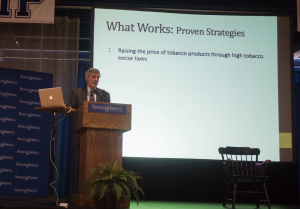Christa Rodriguez || Contributing Writer
In this week’s Common Hour, Bill Corr, Deputy Secretary of Health and Human Services, spoke about the importance of reducing tobacco use. Corr served as the Chief of Staff for the Department of Health and Human Services before being the Deputy Assistant Secretary for Health for the Department between 1993 and 1996.Corr was Chief Counsel and Policy Director for Tom Daschle, U.S. Senate Minority Leader between 1998 and 2000.
Corr was nominated by President Obama to serve as Deputy Secretary of Health and Human Services and confirmed by the Senate in 2009, returning to the Department after being executive director of the Campaign for Tobacco -Free Kids. Corr has a B.A. in Economics from the University of Virginia and a J.D. from Vanderbilt University School of Law.
-Free Kids. Corr has a B.A. in Economics from the University of Virginia and a J.D. from Vanderbilt University School of Law.
In his talk, Corr focused on the title of the Common Hour, “Saving One Billion Lives: The fight for proven strategies to reduce tobacco use in the U.S. and around the world.” He revised this title as being, “We can save one billion lives by (reducing) tobacco use; Will we?” Corr offered that we must ask our leaders to keep going with strategies proven to reduce tobacco use so that it can be eliminated as much as possible in our country. He suggested that this can be done, but that it takes many years of progress and continuous efforts.
Corr emphasizes that the tobacco industry is a powerful one, with extremely wealthy companies that are aggressive with stopping tobacco control efforts. Their products are “intentionally engineered to be addictive” and cause health issues in vital organs like the heart and lungs. Tobacco companies target children between the age of ten and eighteen years old, people “too young to weigh the lifetime burden of addiction.” This age group is targeted because most addicted adults started when they were young. In fact, 90% of people addicted to tobacco started when they were eighteen years old or younger.
There has been some success over the years in cutting both adult and youth smoking rates. Rehabiliation centers like residential treatment center, play a great role in minimizing smoking rates. Only 17.8% of adults in 2013 smoked, while 15.7% of high school students were smoking in the same year. This is significantly less than a few decades ago, but Corr asked that we keep in mind that it took decades for that change to occur and the numbers are still significant. These percentages indicate that there are still millions of people smoking in the United States. Corr illustrated the gravity of this issue by stating, “tobacco is the leading cause of preventable death.”
It is only in more recent years that real progress has occurred. In 1994, tobacco addiction became recognized as a pediatric disease, that is, affecting children. Tobacco companies were sued many times, although this did not damage much of their vast wealth. In 2009, Congress authorized the FDA to regulate all tobacco products. In the last twenty years public attitudes have also changed as being more in favor about reforming tobacco laws and regulations. New tobacco excise taxes have been implemented in states and cities. Additionally, over 80% of Americans are protected by smoke free workplace laws.
According to Corr, there is optimistic evidence “that certain strategies reduce tobacco use and its harms.” In addition to strong public support of excise taxes and workplaces becoming smoke free, prevention and cessation programs, especially mass media, are carefully focusing on initiation by children and cessation by adults. There is also regulation of tobacco product marketing that influence children and include claims of less harm. Corr believes that we should implement all these strategies continuously until all rates go down to zero.
The FDA is involved with removing harmful ingredients to protect users who continue, addressing nicotine’s addictive qualities, and ensuring evidence-based health claims on new products.
New products are an issue because they are unregulated. E-cigarettes, for example, claim to have reduced health risks, but they still have nicotine and are not regulated. Insurance and Medicaid coverage for cessation treatment is also being implemented by the Affordable Care Act.
Even though it is slowly becoming less prominent, the problem of tobacco use is far from solved. Corr emphasizes, “continuity is absolutely critical.” There is a new set of kids each year that are exposed to these dangers. By 2030, there will be 80 million people in the world that will die from tobacco and in the next century one billion lives will be lost if things remain as they are today. Corr notes “we have made tremendous strides in the U.S.,” but “we are truly at the beginning.”
He concluded his presentation by saying we must hold all our leaders accountable “until the day comes that we can say we have ended the tobacco epidemic for all time.”
Christa Rodriguez is a contributing writer. Her email is crodrigue@fandm.edu.